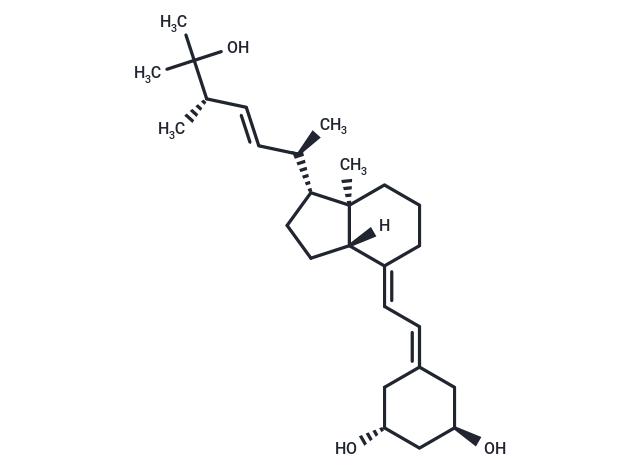Shopping Cart
- Remove All
 Your shopping cart is currently empty
Your shopping cart is currently empty

Paricalcitol is a vitamin D receptor agonist. It is used for the prevention and treatment of secondary hyperparathyroidism associated with chronic renal failure.

| Pack Size | Price | Availability | Quantity |
|---|---|---|---|
| 1 mg | $147 | In Stock | |
| 5 mg | $597 | In Stock | |
| 10 mg | $852 | In Stock | |
| 25 mg | $1,290 | In Stock | |
| 50 mg | $1,730 | In Stock | |
| 100 mg | $2,350 | In Stock |
| Description | Paricalcitol is a vitamin D receptor agonist. It is used for the prevention and treatment of secondary hyperparathyroidism associated with chronic renal failure. |
| In vitro | Paricalcitol (30 nM; HP + PC) produces a significant reduction in calcification relative to the observed in cells in HP medium. Paricalcitol causes a reduction in the levels of nuclear β-catenin to a level similar to that observed in control cells [1]. |
| In vivo | Paricalcitol, administered at a dosage of 300 ng/kg/day, markedly reduces Tau levels and prevents left ventricular (LV) dysfunction in mice. Furthermore, this treatment significantly lowers the mRNA expression of atrial natriuretic peptide (ANP), fibronectin, and collagen III in mice subjected to transverse aortic constriction (TAC-pari) [2]. |
| Animal Research | After TAC or sham surgery, a subset of the mice is treated with paricalcitol which activates the VDR, at a final dose of 300 ng/kg/day. Paricalcitol is dissolved in a 95% propylene glycol and 5% ethyl alcohol solution. Mice were intraperitoneally injected with paricalcitol (or vehicle only) three times per week on Monday, Wednesday, and Friday for five consecutive weeks. An established anti-hypertrophic and anti-fibrotic treatment, namely the angiotensin II receptor blocker (ARB) losartan is also included. Previous experiments have shown it is feasible and efficacious to dissolve losartan in the drinking water at a concentration of 30 mg/kg/day; mice are treated for five consecutive weeks. So, in total eight groups are studied. Sham (n=10), TAC (n=10), Sham + losartan (Sham-los, n=10), TAC + losartan (TAC-los, n=10), Sham + paricalcitol (Sham-pari, n=10), TAC + paricalcitol (TAC-pari, n=10), Sham + paricalcitol + losartan (Sham-combi, n=10) and TAC + paricalcitol + losartan (TAC-combi, n=10) [2]. |
| Molecular Weight | 416.64 |
| Formula | C27H44O3 |
| Cas No. | 131918-61-1 |
| Smiles | [H][C@@]12CC[C@H]([C@H](C)\C=C\[C@H](C)C(C)(C)O)[C@@]1(C)CCC\C2=C/C=C1C[C@@H](O)C[C@H](O)C1 |
| Relative Density. | 1.121 g/cm3 |
| Storage | Powder: -20°C for 3 years | In solvent: -80°C for 1 year | Shipping with blue ice. | ||||||||||||||||||||||||||||||||||||||||
| Solubility Information | H2O: Insoluble Ethanol: 12 mg/mL (38.8 mM), Sonication is recommended. DMSO: 95 mg/mL (228.02 mM), Sonication is recommended. | ||||||||||||||||||||||||||||||||||||||||
Solution Preparation Table | |||||||||||||||||||||||||||||||||||||||||
Ethanol/DMSO
DMSO
| |||||||||||||||||||||||||||||||||||||||||

Copyright © 2015-2024 TargetMol Chemicals Inc. All Rights Reserved.